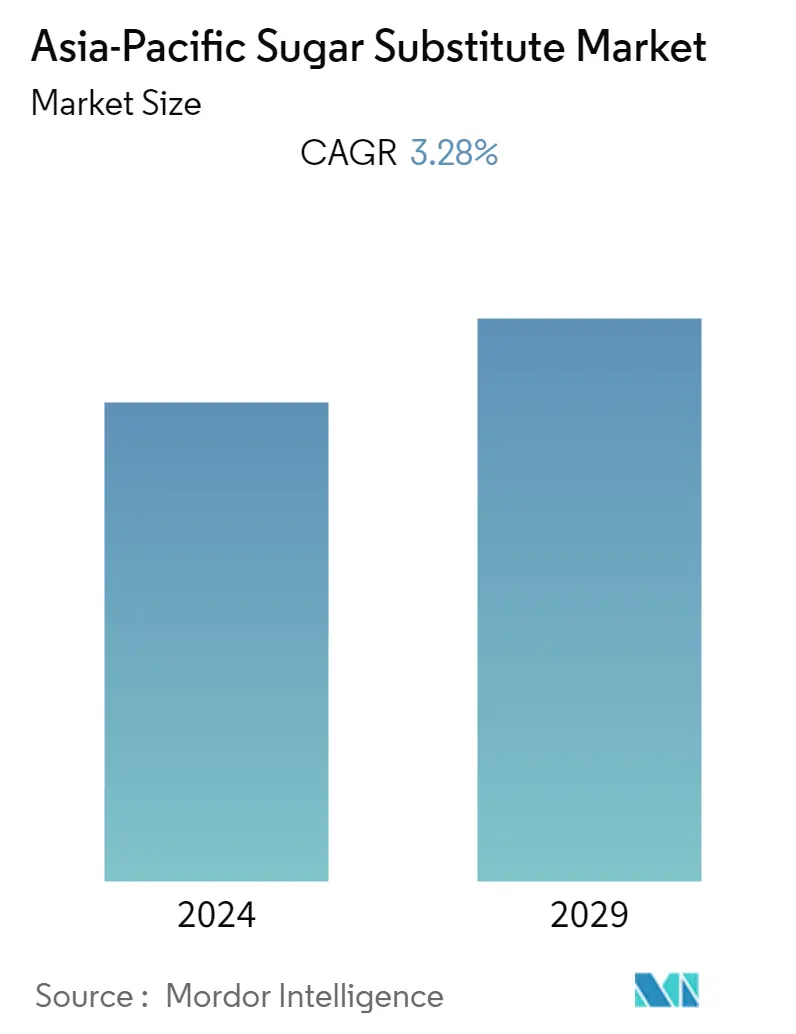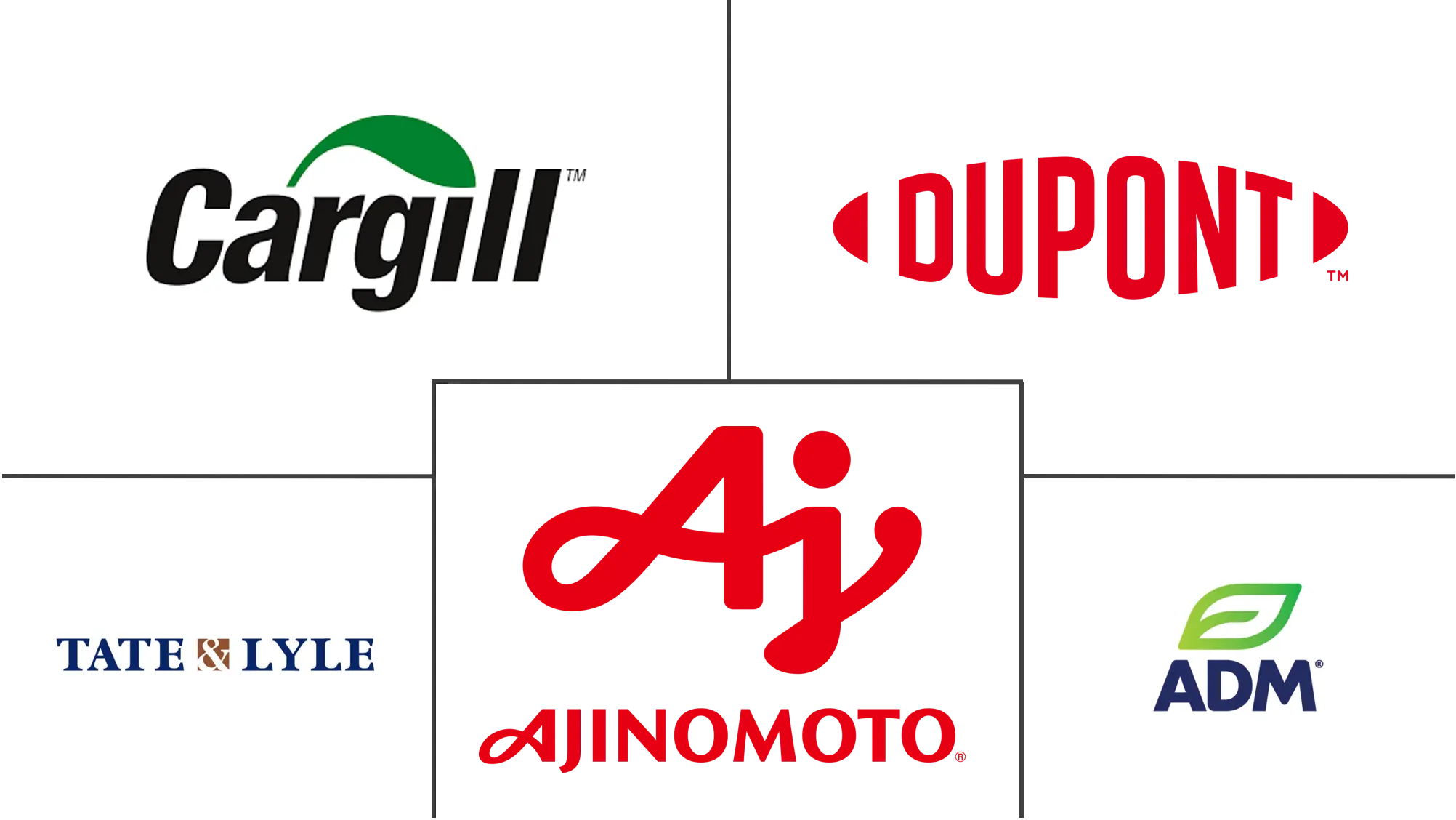Market Size of Asia-Pacific Sugar Substitute Industry

| Study Period | 2019 - 2029 |
| Base Year For Estimation | 2023 |
| Forecast Data Period | 2024 - 2029 |
| Historical Data Period | 2019 - 2022 |
| CAGR | 3.28 % |
| Market Concentration | Low |
Major Players
*Disclaimer: Major Players sorted in no particular order |
APAC Sugar Substitute Market Analysis
Asia-Pacific Sugar Substitute market is projected to grow at a CAGR of 3.28% during the forecast period, 2020 - 2025.
- The increasing prevalence of diabetes and weight-related issues has led to more individuals opting for healthier products made from sugar alternatives, such as natural and non-calorie sweeteners.
- Food product manufacturers are constantly improvising their nutritional labels by incorporating natural sweeteners, catering to the consumer's increasing demand for natural, safe, and healthy sweetener systems. For example, stevia sweeteners can help companies deliver on the significant opportunity for products boasting reduced sugar content. Resultantly, stevia, among other substitutes emerged as the prominent segment, witnessing robust demand in the region.
APAC Sugar Substitute Industry Segmentation
Asia-Pacific Sugar Substitute market includes revenue generated through High-Intensity, Low-Intensity, and High Fructose Syrup. By application the market is segmented into food and beverage, dietary supplement, and pharmaceuticals. Additionally, the study includes market revenue in major countries of the region Asia-Pacific that is India, China, Japan, and Australia.
| Product Type | |||||||
| |||||||
| |||||||
| High Fructose Syrup |
| Application | ||||||||
| ||||||||
| Dietary Supplements | ||||||||
| Pharmaceuticals |
| By Geography | |
| India | |
| China | |
| Japan | |
| Australia | |
| Rest of Asia-Pacific |
Asia-Pacific Sugar Substitute Market Size Summary
The Asia-Pacific sugar substitute market is experiencing significant growth, driven by the rising awareness of health issues such as diabetes and obesity. This has led to a shift in consumer preferences towards healthier alternatives, including natural and non-calorie sweeteners. Food manufacturers are increasingly incorporating these sweeteners into their products to meet the demand for natural, safe, and healthy options. Stevia, in particular, has gained prominence as a preferred substitute due to its ability to reduce sugar content without compromising on taste. The demand for clean label products has further fueled the adoption of natural sweeteners, with both food and beverage sectors actively innovating and launching new products featuring stevia.
China stands out as the leading market for sugar substitutes within the Asia-Pacific region, largely due to its robust end-user industries such as functional beverages, glazed fruits, and medicinal products. The country's significant share in global stevia demand underscores its pivotal role in the market. The Asia-Pacific sugar substitute market is characterized by fragmentation, with major players like Cargill, Archer Daniels Midland Company, and Ajinomoto holding a strong presence. These companies leverage their extensive product portfolios and geographical reach to maintain a competitive edge. They are focused on innovation and strategic expansion to cater to diverse consumer preferences and explore new market opportunities.
Asia-Pacific Sugar Substitute Market Size - Table of Contents
-
1. MARKET DYNAMICS
-
1.1 Market Drivers
-
1.2 Market Restraints
-
1.3 Industry Attractiveness - Porter's Five Forces Analysis
-
1.3.1 Threat of New Entrants
-
1.3.2 Bargaining Power of Buyers/Consumers
-
1.3.3 Bargaining Power of Suppliers
-
1.3.4 Threat of Substitute Products
-
1.3.5 Intensity of Competitive Rivalry
-
-
-
2. MARKET SEGMENTATION
-
2.1 Product Type
-
2.1.1 High-Intensity Sweeteners
-
2.1.1.1 Stevia
-
2.1.1.2 Aspartame
-
2.1.1.3 Cyclamate
-
2.1.1.4 Sucralose
-
2.1.1.5 Other High Intensity Sweeteners
-
-
2.1.2 Low-Intensity Sweeteners
-
2.1.2.1 Sorbitol
-
2.1.2.2 Maltitol
-
2.1.2.3 Xylitol
-
2.1.2.4 Other Low Intensity Sweeteners
-
-
2.1.3 High Fructose Syrup
-
-
2.2 Application
-
2.2.1 Food and Beverage
-
2.2.1.1 Bakery
-
2.2.1.2 Confectionery
-
2.2.1.3 Dairy
-
2.2.1.4 Beverages
-
2.2.1.5 Meat and Seafood
-
2.2.1.6 Other Food and Beverages
-
-
2.2.2 Dietary Supplements
-
2.2.3 Pharmaceuticals
-
-
2.3 By Geography
-
2.3.1 India
-
2.3.2 China
-
2.3.3 Japan
-
2.3.4 Australia
-
2.3.5 Rest of Asia-Pacific
-
-
Asia-Pacific Sugar Substitute Market Size FAQs
What is the current Asia-Pacific Sugar Substitute Market size?
The Asia-Pacific Sugar Substitute Market is projected to register a CAGR of 3.28% during the forecast period (2024-2029)
Who are the key players in Asia-Pacific Sugar Substitute Market?
Cargill, Incorporated , Archer Daniels Midland Company , Ajinomoto Inc., Tate & Lyle PLC and Ingredion Incorporated are the major companies operating in the Asia-Pacific Sugar Substitute Market.

